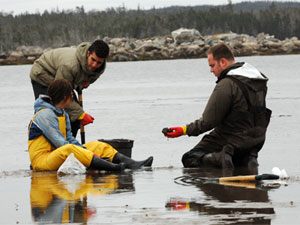 |
| Students in the Intertidal Ecology and Diversity class get down and dirty at Martinique Beach. (Danny Abriel Photo) |
It’s not exactly beach weather, but a group of HÂţ» students have come prepared, not with towels and sunscreen, but toques, gloves, waterproof pants and rubber boots.
On this day, Martinique Beach on Nova Scotia’s Eastern Shore acts as their classroom. The 13 students in Allison Schmidt’s are charged with collecting core samples along the beach and mudflats, taking note of the worms, snails, small crustaceans and tiny bivalves that live in the sand and black mud. They’ll take the samples back to the laboratory at HÂţ» and examine what they found using microscopes.
SEE PHOTO ESSAY: Catch up with the Intertidal Ecology and Diversity class at Martinique Beach. Photos by Danny Abriel.
Ěý
Sitting on the bumper of a SUV, Heather MacGillivray puts one foot, then the other in brown hipwaders that come up under her armpits. She adjusts the suspenders and gives them a snap.
“Sex-ay,” she says with a grin. In the red dirt on the seat of her pants, she bears the evidence of an earlier field trip.
“We have so much fun,” says Ms. MacGillivray, a fourth-year biology student. “It’s better than sitting and listening to a lecture. These classes are much more interactive.”
Seaside—Summer Education and Applied Science Institute at HÂţ» in Ecology—provides a unique experience, getting students out of the university and into the great outdoors. Offered through the Faculty of Science, the program began with two classes in 1996 and this year has expanded with 10 classes, including , and . (There are still some spaces available in classes scheduled later in the summer; check the .)
Two of the classes— and the —are open to non-science majors.
The half-credit classes run Monday to Saturday, over two to three weeks. In that time, students are apt to go on three or four fieldtrips, including some overnight trips. Students in Intertidal Ecology, for example, camped in Annapolis Royal and visited beaches on the Atlantic and Bay of Fundy sides.Ěý Later in the summer, students in will camp for several nights on Brier Island, where they’ll observe whales, dolphins and seals.
“They get to see all the things they’re learning about,” says Cindy Staicer, assistant professor of biology and an expert on the behavior and ecology of birds in natural and managed forest ecosystems. Dr. Staicer also coordinates Seaside and teaches a class on . “Everyone who teaches these classes is teaching something they’re really passionate about.”
Students in her bird class visited Conrad’s Beach, a sand pebble beach about 15 kilometres from Dartmouth, where they observed a pair of endangered Piping Plovers skittering along the sand and singing a soft, flute-like pipe-pipe-pipe-pipe. At Rocky Run, near Lawrencetown Beach, they spotted a majestic Great Blue Heron nesting in a spruce tree.
“The students thought it was amazing,” says Dr. Staicer. “As well as identifying species they see, they’re also learning to recognize birds by their sounds. A walk in the woods will never be the same for them.”
Meanwhile, back on Martinique Beach, fingers have turned icy and more than a few students have soakers from the surf running over the top of their boots. But the sight of worms—pale, fast moving squiggles on the sieve—always seem to elicit squeals of delight. Once the students have gathered samples from the sandy beach, they move to the mudflats on the other side of the dunes to do some more sampling.
“As far back as I can remember, I wanted to study marine biology,” says Tim Lamothe, a fourth-year student from Ottawa, who plops right down in the mud to examine the black glop on his sieve. The mud has a rotten egg smell, indicating the high rate of decomposition by anaerobic bacteria and other small organisms. The rotting organic material provides enormous amounts of food to organisms.
“This is hands-on learning—it’s what we all love … When you’re in the classroom, you doubt yourself, so that’s why this is so important. It refreshes your desire and your tenacity. Hey, I’m sitting here in the mud, but it’s great.”
LINK:
